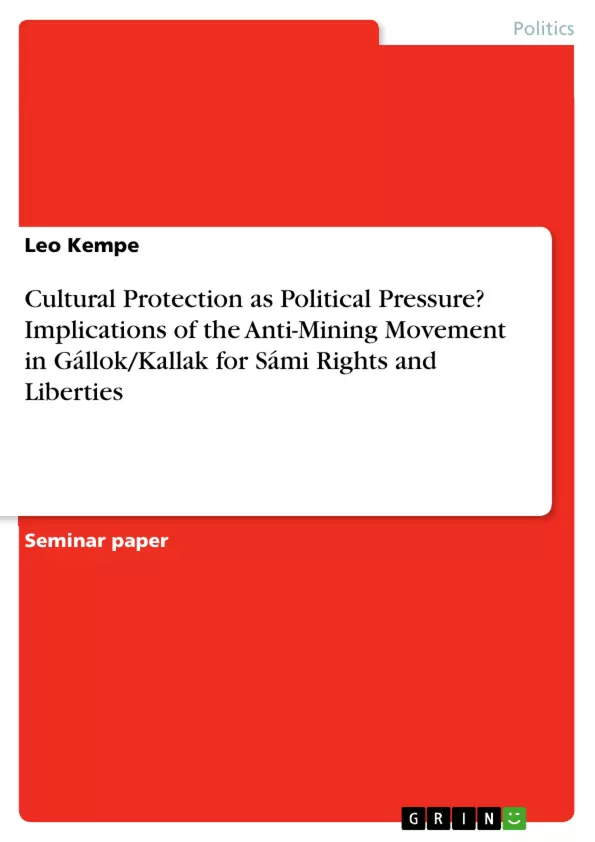This paper illustrates the conflict between the Sámi and the Swedish mining industry in the famous case of Kallak (Sámi: Gállok). A mine was planned to be erected on the lands of the native peoples of Scandinavia and parts of Russia, and these measures angered them. Therefore, they chose to erect a protest camp in which they stayed to prevent bulldozers and excavators from advancing onto their native soil. The Sámi deem it as culturally important because of reindeer herding and other nature-related, life-sustaining activities, which would be severely disrupted by the plans of the Beowulf Mining company.
For context, the paper explores the essentials of Sámi life and their rights, before further diving into the conflictual nature of the Gállok case. Using the concept of (on-site) resistance, the analysis sheds light on the different forms of it as well as on the violent altercations between activists and law enforcement.
Inhaltsverzeichnis (Table of Contents)
- Abstract
- 1. Introduction: Mining in Sámi Traditional Lands
- 2. Theory: The Nature of Resistance
- 2.1. Research Design
- 2.2. Terminology and Concepts: Mining, Reindeer Herding
- 2.3. Theoretical Argument
- 2.4. Hunches
- 3. Empirical Analysis: Gállok/Kallak in Northern Sweden
- 3.1. Method
- 3.2. Operationalization and Materials
- 3.3. Kamp Gállok: On-site Resistance as Crucial Action
- 3.4. Effects on Sámi Rights and Liberties
- 4. Conclusion and Outlook
- 5. Bibliography
Zielsetzung und Themenschwerpunkte (Objectives and Key Themes)
This paper explores the impact of the anti-mining movement in Gállok/Kallak (Gállok) on Sámi rights and liberties in Sweden. The paper aims to analyze the context and nature of the movement, examining its motivations and actions in relation to the ongoing mining industry in Sámi traditional lands. The study uses the Gállok case to shed light on Sámi understandings of human rights, sustainability, and culture.
- The historical and ongoing impact of mining on the Sámi population and their traditional lands.
- The Sámi's perspective on human rights, cultural rights, and the importance of sustainable resource management.
- The role and effectiveness of grassroots resistance movements in protecting indigenous rights and advocating for environmental protection.
- The impact of the Gállok anti-mining movement on Sámi cultural identity and political agency in Sweden.
- The challenges faced by the Sámi in achieving recognition and respect for their rights in a broader political context.
Zusammenfassung der Kapitel (Chapter Summaries)
- Chapter 1: Introduction: Mining in Sámi Traditional Lands
This chapter introduces the historical context of mining in Sámi lands, highlighting the cultural, religious, and economic importance of these lands for the Sámi people. It also discusses the historical marginalization and discrimination faced by the Sámi, leading to the ongoing conflict over mining projects in their territories. - Chapter 2: Theory: The Nature of Resistance
This chapter outlines the research design and methodology employed in the paper, including an inductive approach to understanding the Gállok anti-mining movement. It also defines key terms and concepts such as "reindeer herding" and "mining," outlining their significance within the context of Sámi cultural practices and the conflict with mining interests. - Chapter 3: Empirical Analysis: Gállok/Kallak in Northern Sweden
This chapter focuses on the Gállok case study, analyzing the empirical situation and exploring the motivations and actions of the anti-mining protesters. It aims to highlight the importance of on-site resistance in achieving change and assessing the impact of the movement on Sámi rights and liberties.
Schlüsselwörter (Keywords)
The paper examines the complex intersection of indigenous rights, environmental protection, and economic development within the context of the Sámi people's struggle against mining operations in their traditional lands. Key terms and concepts include: Sámi rights, indigenous rights, cultural protection, mining, reindeer herding, sustainability, resistance movements, Gállok/Kallak, Sweden, land use conflict.
- Citation du texte
- Leo Kempe (Auteur), 2022, Cultural Protection as Political Pressure? Implications of the Anti-Mining Movement in Gállok/Kallak for Sámi Rights and Liberties, Munich, GRIN Verlag, https://www.grin.com/document/1437084



